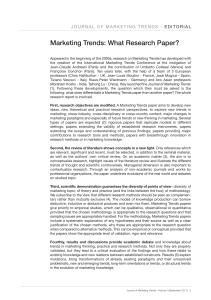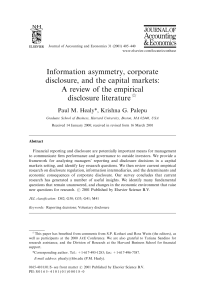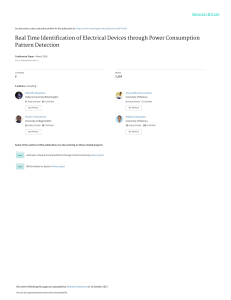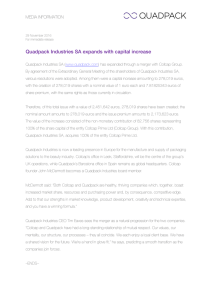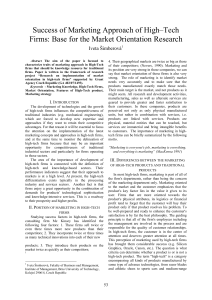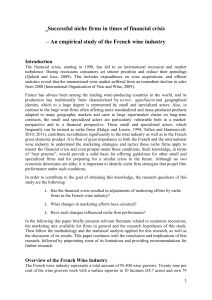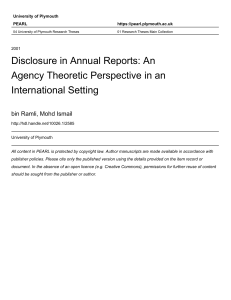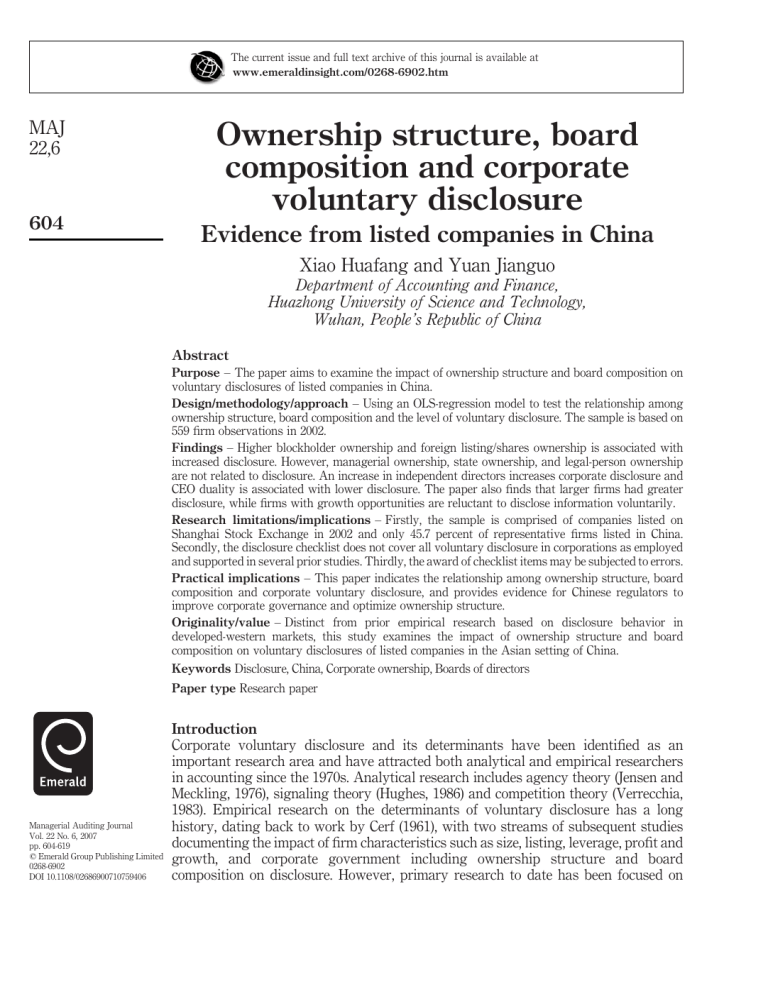
The current issue and full text archive of this journal is available at www.emeraldinsight.com/0268-6902.htm MAJ 22,6 Ownership structure, board composition and corporate voluntary disclosure 604 Evidence from listed companies in China Xiao Huafang and Yuan Jianguo Department of Accounting and Finance, Huazhong University of Science and Technology, Wuhan, People’s Republic of China Abstract Purpose – The paper aims to examine the impact of ownership structure and board composition on voluntary disclosures of listed companies in China. Design/methodology/approach – Using an OLS-regression model to test the relationship among ownership structure, board composition and the level of voluntary disclosure. The sample is based on 559 firm observations in 2002. Findings – Higher blockholder ownership and foreign listing/shares ownership is associated with increased disclosure. However, managerial ownership, state ownership, and legal-person ownership are not related to disclosure. An increase in independent directors increases corporate disclosure and CEO duality is associated with lower disclosure. The paper also finds that larger firms had greater disclosure, while firms with growth opportunities are reluctant to disclose information voluntarily. Research limitations/implications – Firstly, the sample is comprised of companies listed on Shanghai Stock Exchange in 2002 and only 45.7 percent of representative firms listed in China. Secondly, the disclosure checklist does not cover all voluntary disclosure in corporations as employed and supported in several prior studies. Thirdly, the award of checklist items may be subjected to errors. Practical implications – This paper indicates the relationship among ownership structure, board composition and corporate voluntary disclosure, and provides evidence for Chinese regulators to improve corporate governance and optimize ownership structure. Originality/value – Distinct from prior empirical research based on disclosure behavior in developed-western markets, this study examines the impact of ownership structure and board composition on voluntary disclosures of listed companies in the Asian setting of China. Keywords Disclosure, China, Corporate ownership, Boards of directors Paper type Research paper Managerial Auditing Journal Vol. 22 No. 6, 2007 pp. 604-619 q Emerald Group Publishing Limited 0268-6902 DOI 10.1108/02686900710759406 Introduction Corporate voluntary disclosure and its determinants have been identified as an important research area and have attracted both analytical and empirical researchers in accounting since the 1970s. Analytical research includes agency theory (Jensen and Meckling, 1976), signaling theory (Hughes, 1986) and competition theory (Verrecchia, 1983). Empirical research on the determinants of voluntary disclosure has a long history, dating back to work by Cerf (1961), with two streams of subsequent studies documenting the impact of firm characteristics such as size, listing, leverage, profit and growth, and corporate government including ownership structure and board composition on disclosure. However, primary research to date has been focused on the mature capital markets (Meek and Gray, 1989; Gray et al., 1995; Lang and Lundholm, 1996) and emerging markets in Asian such as Hong Kong (China) and Singapore (Hossain et al., 1994; Eng and Mak, 2003). Very few studies (Xiao et al., 2004) have documented corporate voluntary disclosure in mainland China. Accordingly, this study aims to examine the voluntary disclosure behavior of listed companies in China. The orientation of disclosures is significantly influenced by the cultural environment in which companies operate (Gray, 1988; Radebaugh and Gray, 1997). Chinese society is characterized by relatively high levels of collectivism and power distance, and strong uncertainty avoidance (Chow et al., 1995). These societal values indicate that Chinese people would tend to adhere to rules and regulations and disclose less information in their annual reports voluntarily. Hence, Chinese culture in itself does not promote voluntary disclosure of corporate information. On the other hand, long-term creditors in strong uncertainty-avoidance countries such as China may require more information from their borrowers in order to preserve security (Chau and Gray, 2002). The overview of China’s particular societal influences provides us with an opportunity to examine empirically how firm characteristics affect corporate information disclosure in emerging economies. Ownership in China has unique characteristics. As distinct from listed companies in more advanced economies, most listed Chinese firms originated as state-owned enterprises and have three separate classes of ownership shares: state-owned shares, legal-person shares and individual shares. State-owned shares (or Guoyougu in China) held by the government are prohibited from being traded publicly. Legal-person shares owned by separate legal entities also cannot be traded on the Shanghai Stock Exchange (SSE) or the Shenzhen Stock Exchange (SZSE), although these can be sold to other legal entities with the approval of government. Shares issued to individuals can be classified into those restricted to domestic trading by Chinese citizens (A-shares), and those that can be sold to foreign individuals and entities (B-shares), and those listed on Hong Kong and foreign stock exchanges (all called H-shares). At the end of 2000, there were a total of 374.628 billion shares trading on both two exchanges, and only 35.62 percent belonged to individual shareholders, while state shares and legal-person shares constituted 37.35 and 27.03 percent, respectively, (CCX International, 2001). Though studies have examined the effect of state ownership dominance on corporate performance (Xu and Wang, 1999; Sun and Tong, 2003), little research exists on the impact of China’s unique ownership structure on voluntary corporate disclosure. To examine the effect of China’s Corporate Government reform on disclosure is the final reason that we are examining voluntary disclosure in China. During the past decade, the Chinese Government has continued to improve its corporate governance policies so as to prepare Chinese companies to compete with their foreign counterparts, especially with China’s entry into the Word Trade Organization (WTO) in late 2001. The Ministry of Finance and the Chinese Securities and Regulations Commission (CSRC, 2001, 2002a) released “Guidelines for Introducing Independent Directors to the Board of Directors of Listed Companies” in 2001and “Code of Corporate Governance for Listed Companies in China” in 2002. The guidelines mandated every company in China to install at least two independent directors (IND) on the board by June 30 2002, and to ensure that a third of the board is occupied by IND by June 30 2003. In addition, IND are required to comment on the appropriateness of management actions in the company’s annual reports. Outside of China, however, little is known about the effectiveness of these reforms in promoting voluntary disclosure. Impact of ownership structure 605 MAJ 22,6 606 Accordingly, in light of said unique-cultural environment, this study examines whether ownership structure and board composition are associated with voluntary disclosure of listed companies in China. Ownership structure is characterized by blockholder ownership, managerial ownership, state ownership, legal-person ownership and foreign listing/shares ownership, and board composition is measured by the percentage of IND and CEO duality (CEOs who jointly serve as board chairs). Voluntary disclosure is proxied by an aggregated disclosure score (DSCORE) of background information, business information, financial information and other non-financial information. The remainder of this paper is organized as follows. Section 2 reviews prior research on the determinants of corporate disclosure. The hypotheses are developed in Section 3. Section 4 describes our method, sample and data, and Section 5 presents the analyses and results. Finally, some conclusions are drawn. Determinants of corporate disclosure A considerable international literature has developed which investigates the association between corporate characteristics and disclosure levels in corporate annual reports. These studies have developed a disclosure index or score to measure voluntary disclosure in financial statements. Firth (1979) finds that larger firms are more inclined to disclose more information because they are prone to public scrutiny. Chow and Wong-Boren (1987) examine the association between voluntary disclosure and firm size (FSIZE), proportion of assets, and financial leverage. The study concludes that voluntary disclosure varies widely within a sample of 52 Mexican firms, and the extent of disclosure is positively related to FSIZE only. The findings of Cooke (1992) suggest that size, operation in the manufacturing sector, and listing on foreign stock markets induce Japanese firms to disclose more information. According to the research of Naser et al. (2002), FSIZE, debt ratio, profit margin, and audit FSIZE are positively correlated, while liquidity is negatively correlated to the depth of disclosure Another determinant of the level of voluntary disclosure is the firm’s ownership structure. The extent of shareholding by executive directors is associated with agency theory (Jensen and Meckling, 1976). Shareholdings by non-executive directors (Jensen, 1993) and by outside blockholders (Shleifer and Vishny, 1986) are associated with higher monitoring incentives. Ruland et al. (1990) find that firms which release earnings forecasts have a higher proportion of outside ownership than do other firms. Eng and Mak (2003) argue that lower managerial ownership and significant-government ownership are associated with increased disclosure. However, they find that blockholder ownership is not related to disclosure. Based on a study of voluntary disclosure by Hong Kong and Singapore firms, Chau and Gray (2002) report a positive relationship between outside ownership and disclosure, consistent with the findings of Hossain et al. (1994). Additionally, corporate governance, which promotes corporate transparency and accountability, is predicted to be significantly associated with voluntary disclosure. Jensen (1993) argues that board composition and board-leadership structure are associated with board-monitoring incentives. Forker (1992) examines the association between corporate governance and share option disclosures. Chen and Jaggi (2000) find that the ratio of independent board directors is positively associated with mandatory disclosures. Eng and Mak (2003) report an inverse relationship between outside directors and voluntary disclosure, Gul and Leung (2004) suggest that CEO duality is associated with lower levels of voluntary corporate disclosures. However, the negative CEO duality and voluntary disclosure association is weaker for firms with a higher proportion of independent and experienced directors on the board. We extend the work of Eng and Mak (2003) by examining corporate governance in terms of ownership structure including legal-person ownership, and board composition including CEO duality in China. Impact of ownership structure Hypotheses Blockholder ownership Blockholder ownership is the percentage of shares held by substantial shareholders (that is, shareholdings of 5 percent or more). Jensen and Meckling (1976) argue that substantial shareholders are expected to have both greater power and incentives to monitor management, as their wealth is tied to the firm’s financial performance. Fama and Jensen (1983) propose that diffusion in ownership raises the potential conflicts between the principal and the agent. Agency problems can be mitigated by involving substantial shareholders in monitoring or controlling activities that potentially cause such problems (Shleifer and Vishny, 1986; Huddart, 1993; Noe, 2002). Therefore, managers are predicted to disclose more information in annual reports in order to reduce agency costs entailed in monitoring activities. Hossain et al. (1994) and Chau and Gray (2002) provide support for this prediction in revealing an association between the ownership structure and the extent of information voluntarily disclosed by the listed Malaysian, Hong Kong and Singapore firms, respectively. The hypothesis is thus: 607 H1. Ceteris paribus, there is a positive association between blockholder ownership and the extent of voluntary disclosure. Managerial ownership Managerial ownership is the proportion of ordinary shares held by senior managers, including directors and supervisors. The extent of managers’ shareholdings can reduce agency costs as it serves to align the interests of management with those of other shareholders (Jensen and Meckling, 1976). Agency theory predicts that there is a positive association between management interests and the level of voluntary disclosure. Warfield et al. (1995) provide evidence supporting this contention in their findings that the extent of shareholding by management is positively associated with the amount of information disclosed about earnings. Hence, our hypothesis is: H2. Ceteris paribus, there is a positive association between managerial ownership and the level of voluntary disclosure. State ownership The Chinese Government has more than 10 percent of direct or indirect voting rights in 43.8 percent of firms, and more than 50 percent in 31.4 percent of firms (Tian, 2001). These state-owned shares are not publicly tradable and the state shareholders may focus on wealth distribution and maintaining social order (Xu and Wang, 1999). That is, enhancing shareholder value may not be the primary objective of state ownership enterprises (SOEs). In addition, the government would also be able to obtain information from other sources and be more likely to gain easier access to different channels of financing than non-state firms (Eng and Mak, 2003). Both factors should weaken the pressures for voluntary disclosures directed at the public. Hence, there may MAJ 22,6 be less disclosure in corporations with a higher proportion of state-ownership corporation, as stated in the following hypothesis: H3. Ceteris paribus, there is a negative association between state ownership and the level of voluntary disclosure. 608 Legal-person ownership With respect to legal-person ownership, the holders of these shares have more resources and expertise to monitor listed firms than do individual investors. Additionally, compared with state shareholders, legal-person shareholders have great incentive to monitor firms because they are more concerned with profits than fulfilling political and social goals (Xiao et al., 2004). It is expected that the extent of voluntary disclosure increases with their proportion of legal-person ownership, as stated in the following hypothesis: H4. Ceteris paribus, there is a positive association between legal-person ownership and the level of voluntary disclosure. Foreign listing/shares ownership In general, due to space and language barriers, foreign shareholders likely face a higher level of information asymmetry. This is particularly true of listed Chinese companies, given the difficulty in accessing hard copy corporate reports (Xiao et al., 2004). In order to compete effectively in the capital market, firms with foreign listing/shares would voluntarily disclose more information. In contrast to firms with only A-shares, Chinese companies issuing B-or H-shares are required to also follow International Accounting Standards (IAS) or the accounting standards of the foreign countries where their shares are listed. If they disclose information to overseas investors, whether mandatory or voluntary, they are required to disclose the same to domestic shareholders. In addition, reports to B- and H-shareholders must be audited by international auditors, which would increase voluntary disclosure (DeAngelo, 1981). Cooke (1998) reports that firms which are listed on several stock exchanges make more information disclosures. Hence, the following hypothesis is proposed: H5. Ceteris paribus, there is a positive association between foreign listing/share ownership and the level of voluntary disclosure. Independent directors As representatives of shareholders, IND are perceived as tools for monitoring management behavior (Rosenstein and Wyatt, 1990). Benefiting from established reputations as monitoring experts, IND have incentives to increase the quantity and quality of disclosure (Fama and Jensen, 1983). Beasley (1996) argues and provides evidence that the proportion of IND is positively related to the board’s ability to influence disclosure decisions. Chen and Jaggi (2000) find empirical evidence of a positive relationship between the proportion of IND and disclosure (including mandatory disclosure). Thus, the hypothesis relating outside directors to voluntary disclosure is as follows: H6. Ceteris paribus, there is a positive association between the proportion of outside directors and the level of voluntary disclosure. CEO duality Fama and Jensen (1983) point out that CEO duality signals the absence of separation of decision control and decision management. The result of CEO duality is the concentration of decision-making power, which could constrain board independence and reduce its ability to execute its oversight and governance roles (Finkelstein and D’Aveni, 1994; Gul and Leung, 2004), and prove detrimental to disclosure levels and quality, especially voluntary disclosure (Ho and Wong, 2001).This issue is considered important enough for the CSRC in 2001 to recommend that large companies should separate the roles of CEO and chairman. The above reasoning suggests that firms with CEO duality are more likely to be associated with lower levels of voluntary disclosures. The hypothesis is thus: H7. Ceteris paribus, there is a negative association between CEO duality and the level of voluntary disclosure. Other control variables To test the main hypotheses, we selected several factors that had been identified by the extant literature as relevant to voluntary disclosure as control variables in multiple-regression models. FSIZE was included because larger firms are subject to more public and regulatory scrutiny (Watts and Zimmerman, 1986) and thus are likely to voluntarily disclose more information to muster public support for reducing political costs and to raise capital (Chow and Wong-Boren, 1987; Lang and Lundholm, 1993). We also included leverage (DEBT) because firms with high-debt levels are expected to incur higher monitoring costs. Thus, managers of high-debt firms seek to reduce these costs by disclosing more information in annual reports (Ahmed and Courtis, 1999). We proxy leverage with the ratio of total liability to total assets because Chinese-listed firms usually roll over short-term loans as a means of obtaining long-term financing (Xiao et al., 2004). High-growth firms have greater information asymmetry and agency costs (Smith and Watts, 1992; Gaver and Gaver, 1993) and thus have incentives to narrow this information gap by more voluntary disclosure. We use the proportion of intangible assets to proxy growth. Finally, the high-quality of audit (BIG4) is also adopted as a control variable (Inchausti, 1997) Research method Sample The sample for this paper is drawn from firms listed on the SSE of China at the end of 2002. Firms in the financial sector (banks, insurance, and other financial firms) are excluded, as they are subject to different disclosure requirements in China. ST/PT firms are also excluded because their financial conditions are abnormal. In addition, the CSRC mandates special-venture disclosure for the real-estate industry, so these firms are neglected. Apart from one firm without an annual report, we obtained a total of 559 firm observations for hypotheses testing. We cover 11 industry sectors, with 345 firms in manufacturing; 51 firms in retail/trade; 32 firms in both conglomerate and transport and storage; 26 firms in utilities; 24 firms in communication; 16 firms in the services sector; 14 firms in agriculture, forestry, animal husbandry and fisheries; 7 firms in construction; 6 firms in mining; and 5 firms in media and culture. Impact of ownership structure 609 MAJ 22,6 610 The measurement of voluntary disclosure In this paper, we adopt the level of voluntary disclosure of our sample firms as a measure of their voluntary disclosures in annual reports for three reasons. First, annual report disclosure levels are positively correlated with the amount of disclosure provided via other media (Lang and Lundholm, 1993). Second, disclosures in annual reports are regarded by financial analysts and investors as the most important source of information for Chinese firms. Finally, corporate disclosure of management forecasts (i.e. earnings forecasts) is rare in China. Chinese publicly listed companies are required to prepare annual reports in accordance with China’s GAAP and (CSRC, 2002b) “The No. 2 rule of content and format about information disclosure in companies issuing securities to the public: The content and format of the annual report (Revised in 2002),” which are issued by Ministry of Finance and CSRC, respectively. Following Botosan (1997) and Meek et al. (1995), we develop an index to measure the extent of voluntary disclosure by companies in the 2002 annual reports. The items in our disclosure list are modified from Botosan (1997) to take into account the disclosure environment in China. The final-disclosure list containing 30 items is reported in the Appendix. It contains background information, business information, financial information and non-financial information. The background information includes corporate goals, strategy and competition. Business information includes items such as changes in sales, changes in costs of goods, and profit forecast. Financial information includes gearing ratio, liquidity ratio, inventory turnover, and turnover of receivables. Non-financial information includes staff training, ISO issues, and corporate culture. For each item in the disclosure index, a company receives a score of “1” if it voluntarily discloses information on the item and a “0” otherwise (Botosan, 1997; Meek et al., 1995). DSCORE is the sum of scores awarded for each item in the disclosure index. This voluntary disclosure index was complied based on the unweighted scoring approach of the disclosure items, which has been employed and supported in several prior studies (Ahmed and Nicholls, 1994; Cooke, 1991; Meek et al., 1995). Definition and measurement of variables Table I summarizes the definition and measurement of variables used in this paper. All of the data were collected from Center of China Economic Research Services (CCER). Regression mode A linear-multiple regression analysis was used to test the association between the dependent variable of voluntary disclosure and the independent variables of ownership structure and board composition. The following model is estimated: SCOREi ¼ b0 þ b1 BLOCKi þ b2 MOWNi þ b3 SOEi þ b4 LEGALi þ b5 FSHi þ b6 IDRi þ b7 DUALi þ b8 FSIZEi þ b9 DEBTi þ b10 INTANi þ b11 BIG4i þ 1i where, DSCORE – voluntary disclosure score; BLOCK – proportion of equity ownership by substantial shareholders (with equity of 5 percent or more); MOWN – proportion of equity ownership by senior managers, including directors and supervisors; SOE – proportion of equity ownership by the state; LEGAL – proportion of equity ownership by Variable Definition Dependent variable DSCORE Voluntary disclosure score Independent variables BLOCK Blockholder ownership MOWN Managerial ownership SOE LEGAL State ownership Legal-person ownership FSH Foreign listing/shares ownership INR DUAL Independent director CEO duality Control variables FSIZE Firm size DEBT Leverage ratio INTAN Intangible assets ratio BIG4 Auditor reputation Measurement Total number of points awarded for voluntary disclosure of strategic, business, financial and non-financial information Proportion of ordinary shares owned by substantial shareholders(with equity of 5 percent or more) Proportion of ordinary shares owned by top managers(including directors and supervisors Proportion of ordinary shares owned by the state Proportion of ordinary shares owned by the legal person 1 if the firm had issued H-share or B-share, 0 otherwise Proportion of independent directors on the board 1 if the CEO is also chairman of the board, 0 otherwise The firm’s total assets at fiscal year end of 2002 Total liabilities divided by total assets Total intangible assets divided by total assets 1 if auditor is big-four firm, 0 otherwise legal person; FSH – dummy variable for foreign listing/shares ownership, 1 if the firm had issued H-share or B-share, 0 otherwise; IDR – proportion of IND on the board of directors; DUAL – dummy variable for CEO duality, 1 if the CEO is also chairman of the board, 0 otherwise; FSIZE – logarithm of firm’s total assets at fiscal year end of 2002; DEBT – total liabilities divided by total assets; INTAN – total intangible assets divided by total assets; BIG4 – dummy variable for auditor reputation, 1 if the firm is audited by Big 4 auditor, 0 otherwise. Empirical results Descriptive statistics and univariate analysis Table II contains descriptive statistics for the dependent and independent variables. The average voluntary DSCORE for our sample of firms for 2002 is 4.92 (range from 0 to 21), suggesting a low-voluntary disclosure environment in China. The mean of BLOCK is about 0.56 revealing that the ownership in China is considerably concentrated. The mean of SOE and LEGAL is about 0.38 and 0.23, respectively, and the total-illiquidity share is about 61 percent. Across the 559 companies, the mean percentage of managerial ownership is about 0.48 percent, greatly lower than the average ownership of 14 percent of 158 Hong Kong companies in 1995 (Eng and Mak, 2003). The average percentage of IDR is 0.24 and does not reach the requirement of the CSRC (at least 1/3 IND on the board). In the test sample, slightly more than 11 percent of companies have CEO duality, indicating that the phenomenon of CEO duality has improved gradually. Table III reveals a number of significant correlation among the dependent and independent variables. The analysis shows that voluntary DSCORE is positively correlated with BLOCK, MOWN, SOE, FSH and IDR, and negatively associated with Impact of ownership structure 611 Table I. Definition and measurement of variables MAJ 22,6 612 Table II. Descriptive statistics for study variables Variables SCORE BLOCK MOWN SOE LEGAL FSH IDR DUAL FSIZE DEBT INTAN BIG4 Minimum Maximum Mean Std. deviation 0 0 0 0 0 0 0 0 8.35 0.02 0 0 21 0.96 0.75 0.89 0.86 1 0.56 1 11.57 0.85 0.29 1 4.92 0.56 0.0048 0.38 0.23 0.08 0.24 0.11 9.20 0.42 0.03 0.01 2.91 0.15 0.04 0.27 0.25 0.27 0.08 0.32 0.39 0.16 0.04 0.11 Notes: This table presents descriptive statistics for the total sample of 559 firm observations in 2002. Variables are defined in Table I LEGAL and DUAL. The disclosure levels are also positively correlated to FSIZE, DEBT and BIG4. The positive correlations between DSCORE and these firm characteristics are consistent with the results of prior studies, as discussed in Ahmed and Courtis (1999). Multivariate hypothesis test The use of this statistical tool is based on the assumption of no significant multicollinearity between the explanatory variables. The maximum Pearson correlation among explanatory variables is 0.458, between SOE and BLOCK. Applying the cutoff of correlation coefficient values of 0.8 or higher for multicollinearity to be considered as troublesome according to Judge et al. (1980), the problem of multicollinearity is minimal. In addition, the maximum variance inflation factor (VIF) is 1.351, which is lower than ten, a number that is used as a rule of thumb as an indicator of multicollinearity problems (Belsely, 1991). Thus, these results further support the lack of presence of multicollinearity in the research model. The results of the regression analysis can, therefore, be interpreted with a greater degree of confidence. Table IV displays the result of the OLS regression model used to test H1-H7. The F-value of Chinese companies in 2002 is 5.364 (significant at 0.01) for the level of voluntary disclosure. The adjusted coefficient of determination (R 2) for the level of voluntary disclosure is 7.9 percent, suggesting that there are other related variables ignored in our model. The result show that two aspects of ownership – blockholder ownership and foreign listing/shares ownership – are significant at the 0.05 level related to voluntary disclosure. Voluntary disclosure increases with greater blockholder ownership (b1 ¼ 2.951, t ¼ 3.21), and with listing on foreign stock exchanges or issuing shares to foreigners (b5 ¼ 1.014, t ¼ 2.146), which support H1 and H5. The other three aspects of ownership – managerial ownership, state ownership, and legal-person ownership – are not significant at the 0.05 level related to voluntary disclosure. Thus, H2-H4 are not supported. These results of zero association is different from the results in Eng and Mak (2003), as they found a negative relationship between managerial ownership and disclosure and a positive association between state BLOCK MOWN 0.049 0.458 * * 20.142 * * 1 20.025 0.039 20.033 20.088 * 0.191 * * 20.010 20.047 0.067 SOE 2 0.014 2 0.049 2 0.020 2 0.025 1 2 0.026 0.024 2 0.013 2 0.016 0.069 0.019 0.001 LEGAL IDR 0.153 * * 0.103 * * 0.042 0.052 20.033 0.018 0.039 20.033 20.026 0.024 1 0.056 0.056 1 20.003 0.053 0.371 * * 0.051 0.092 * 0.012 20.003 0.010 0.203 * * 0.080 * FSH 2 0.082 * 2 0.039 2 0.038 2 0.093 * 2 0.021 0.000 0.054 1 2 0.019 0.018 2 0.037 2 0.040 DUAL 0.195 * * 0.167 * * 20.093 * 0.191 * * 20.016 0.371 * * 0.051 20.010 1 0.241 * * 20.051 0.199 * * FSIZE 0.045 2 0.157 * * 2 0.102 * * 2 0.010 0.069 0.092 * 0.012 0.045 0.241 * * 1 2 0.019 2 0.066 DEBT BIG4 0.059 0.129 * * 2 0.003 0.067 0.001 0.203 * * 0.080 * 2 0.040 0.199 * * 2 0.066 2 0.004 1 INTAN 20.125 * * 20.077 * 20.011 20.047 0.019 20.003 0.010 0.011 20.051 20.019 1 20.004 Notes: This table reports Pearson correlations. The sample is based on 559 firm observations in 2002. Variables are defined in Table I. *Correlation is significant at the 0.05 level (one-tailed). * *Correlation is significant at the 0.01 level (one-tailed) SCORE 1 0.163 * * 0.043 BLOCK 0.163 * * 1 2 0.036 MOWN 0.043 20.036 1 SOE 0.049 0.458 * * 2 0.142 * * LEGAL 2 0.014 20.049 2 0.020 FSH 0.153 * * 0.042 2 0.033 IDR 0.103 * * 0.052 0.018 DUAL 2 0.100 * 20.048 2 0.038 FSIZE 0.195 * * 0.167 * * 2 0.093 * DEBT 0.045 20.157 * * 2 0.102 * * INTAN 2 0.125 * * 20.077 * 2 0.011 BIG4 0.059 0.129 * * 2 0.003 SCORE Impact of ownership structure 613 Table III. Correlation coefficients between the variables MAJ 22,6 614 Table IV. Multiple regression results Independent variables (Constant) BLOCK MOWN SOE LEGAL FSH IDR DUAL FSIZE DEBT INTAN BIG4 Unstandardized coefficients B Std. error 2 6.276 2.951 3.856 2 0.556 2 0.078 1.014 3.124 2 0.906 0.977 0.628 2 6.818 2 0.314 3.084 0.919 2.993 0.504 0.477 0.472 1.471 0.373 0.346 0.784 2.666 1.108 Standardized coefficients Beta T Sig. Collinearity statistics VIF 0.152 0.053 2 0.052 2 0.007 0.095 0.087 2 0.099 0.132 0.035 2 0.104 2 0.012 2 2.035 3.210 1.288 2 1.104 2 0.163 2.146 2.124 2 2.426 2.821 0.801 2 2.557 2 0.284 0.042 0.001 0.198 0.270 0.870 0.032 0.034 0.016 0.005 0.424 0.011 0.777 1.351 1.038 1.327 1.009 1.188 1.019 1.016 1.325 1.138 1.009 1.092 Notes: This table reports multiple regression results of the relationship between ownership structure, board composition and other specific characteristics with the level of voluntary disclosures. Variables are defined in Table I. R 2 ¼ 0.097. Adjusted R 2 ¼ 0.079. F-significance ¼ 0.000. Durbin-Watson test ¼ 2.021. Number of significant coefficients ¼ 6. N ¼ 559 ownership and disclosure. The first reason for the lack of relationship between managerial ownership and voluntary disclosure is that the proportion of managerial ownership is too low (the mean of managerial ownership is only 0.48 percent in this paper) to give rise to effective promptings to senior managers. Secondly, Chinese-managerial ownership in listed firms has two conspicuous characteristics that distinguish it from managerial ownership in the West: it is encouragement not for good behavior but by qualifications of employees in the firms; in addition, this kind of encouragement is historical and aimed at the past. Thus, this kind of encouragement cannot bring effective promptings. The negative relationship is insignificant in state ownership and voluntary disclosure. A possible explanation of this result is that China now encourages companies to raise corporate transparency, and state-ownership firms have began to pay attention to voluntary disclosure. The insignificant coefficient for LEGAL is consistent with the findings in Xiao et al. (2004) which state that legal-person ownership significantly affects internet-based mandatory disclosures, but not internet-based voluntary disclosures. They argue that greater shareholdings by a legal person do not induce disclosures beyond those mandated by regulatory agencies. For the board composition, the result shows that the percentage of IND on board and CEO duality are significant at the 0.05 level related to voluntary disclosure. Voluntary disclosure increases with a greater percentage of IND on the board (b6 ¼ 3.124, t ¼ 2.124), which supports H6 and is consistent with the findings in Chen and Jaggi (2000), who found comprehensive financial disclosures (mandatory and voluntary) to be positively correlated with the proportion of IND on corporate boards. In addition, voluntary disclosure decreases with CEO duality (b7 ¼ 2 0.906, t ¼ 2 2.426), which supports H7 and reflects Forker’s (1992) findings of a significant-negative relationship between a dominant personality and quality (extent) of disclosure. Of the control variables, larger firms (t ¼ 2.821) tend to exhibit more voluntary disclosure. This result supports numerous previous empirical studies on the association between firm-specific characteristics and voluntary disclosure. We also find that firms with higher percentage of intangible assets (t ¼ 2 2.557) are reluctant to disclose more information, which is contrary to the study of Gaver and Gaver (1993). Perhaps, the lax enforcement to Intellectual Property Protection Law in China prevents such firms from protecting their interests. In order to protect their core competitiveness and intangible assets, firms with growth opportunities tend to forestall disclosure. However, we find no significant relationship between disclosure and audit reputation. A possible explanation of this result is that while auditors in BIG 4 likely ensure that companies have compiled with mandatory-disclosure requirements, they still do not actively encourage companies to disclose information beyond that what is mandatory. The leverage ratio is not associated with voluntary disclosure, which is consistent with the findings of Chow and Wong-Boren (1987) and Wallace et al. (1994). This may be explained by the fact that creditors may share private information with their debtors. Conclusions In this study, we examine the impact of ownership structure and board composition on corporate voluntary disclosure. We extend previous studies on the determinants of corporate disclosure in three ways. First, unlike the primary research that to date have focused on mature capital markets and Asian emerging markets such as those in Hong Kong (China) and Singapore, we examine corporate governance and corporate voluntary disclosure in China. Second, we look at the impact of five attributes of ownership structure on disclosure: blockholder ownership, managerial ownership, state ownership; legal-person ownership, and foreign listing/shares ownership. Third, we examine the impact of board composition on corporate disclosure. Board composition is measured by the proportion of IND and CEO duality. We also control for the impact of FSIZE, leverage, growth opportunities and auditor reputation on corporate voluntary disclosure. To measure disclosure, we use an aggregated DSCORE that measures voluntary disclosure of background information, business information, non-financial and financial information. Based on a sample of 599 Chinese-listed firms, we find that higher blockholder ownership and significant foreign listing/shares ownership is associated with increased-voluntary disclosure. Managerial ownership, state ownership and legal-person ownership are not related to disclosure. An increase in IND improves voluntary disclosure and CEO duality reduces disclosure. Finally, we find that larger firms have greater disclosure, while firms with growth opportunities are reluctant to disclose information. Our results have implications regarding policy. First, state ownership and legal-person ownership are insignificant relative to voluntary disclosure, but blockholder ownership and foreign listing/shares ownership is positively associated with voluntary disclosure. Thus, Chinese regulators should commit to facilitating multi-ownership and optimize ownership structure, while expanding the number and size of companies listed abroad gradually. In this way, an effective corporate-governance mechanism will materialize to improve the level of voluntary disclosures in China. Second, when introducing the stock compensation plans of senior managers in the West, Chinese regulators should establish guidelines for companies to establish performance-appraisal systems and its corresponding-incentive mechanisms. Using a performance-appraisal index to Impact of ownership structure 615 MAJ 22,6 616 implement the ownership-incentive mechanism, the stock compensation of senior managers would be associated with the performance of the company. This kind of mechanism can enhance the enthusiasm of senior managers and improve the level of internal governance and voluntary disclosure. Third, Chinese regulators should strengthen the network of IND and induce listed companies to raise the proportion of IND and encourage the separation of Chairman of the board of directors and CEO roles. This study has some limitations. Firstly, the sample is comprised of companies listed on SSE and 45.7 percent of representative firms listed in China. Therefore, the results may not be applied to all listed companies, especially as they were only for 2002. Secondly, the disclosure checklist does not cover all voluntary disclosures in corporations as employed and supported in several prior studies. Thirdly, the award of checklist items may be subjected to errors. However, measures were put into place to ensure that the annual reports were fully understood before they were used. Despite these limitations, the paper does provide useful insights. Future research could conduct a longitudinal study to examine factors that contribute to the change of corporate-voluntary disclosure over time. In addition, using a larger sample or extending the current research by comparing samples in China to those of other South-East Asian countries is an avenue for future research. References Ahmed, K. and Courtis, J. (1999), “Associations between corporate characteristics and disclosure levels in annual reports: a meta-analysis”, British Accounting Review, Vol. 31, pp. 35-61. Ahmed, K. and Nicholls, D. (1994), “The effect of non-financial company characteristics on mandatory disclosure compliance in development countries: the case of Bangladesh”, The International Journal of Accounting, Vol. 29 No. 1, pp. 62-77. Beasley, M. (1996), “An empirical analysis of the relation between the board of director composition and financial statement fraud”, The Accounting Review, Vol. 71 No. 4, pp. 443-65. Belsely, D.A. (1991), Conditioning Diagnostics: Collinearity and Weak Data in Regressions, Wiley, New York, NY. Botosan, C.A. (1997), “Disclosure level and the cost of equity capital”, The Accounting Review, Vol. 72 No. 3, pp. 323-49. CCX International (2001), 2001 China Listed Company Reports, China Finance and Economics Publishing, Beijing (in Chinese). Cerf, A.R. (1961), Corporate Reporting and Investment Decisions, University of California Press, California, CA. Chau, G.K. and Gray, S.J. (2002), “Ownership structure and corporate voluntary disclosure in Hong Kong and Singapore”, The International Journal of Accounting, Vol. 37, pp. 247-65. Chen, C.J.P. and Jaggi, B. (2000), “Association between independent non-executive directors, family control and financial disclosures in Hong Kong”, Journal of Accounting & Public Policy, Vol. 19, pp. 285-310. Chow, C.W. and Wong-Boren, A. (1987), “Voluntary financial disclosure by Mexican corporations”, Accounting Review, Vol. 62 No. 3, pp. 533-41. Chow, L.M., Chau, G.K. and Gray, S.J. (1995), “Accounting reforms in China: cultural constraints on implementation and development”, Accounting & Business Research, Vol. 26, pp. 29-49. Cooke, T.E. (1991), “An assessment of voluntary disclosure in the annual reports of Japanese corporations”, International Journal of Accounting, Vol. 26 No. 3, pp. 174-89. Cooke, T.E. (1992), “The effect of size, stock market listing and industry type on disclosure in the annual reports of Japanese listed corporations”, Accounting & Business Research, Vol. 22 No. 87, pp. 229-37. Cooke, T.E. (1998), “Regression analysis in accounting disclosure studies”, Accounting & Business Research, Vol. 28 No. 3, pp. 209-24. CSRC (2001), Guidelines for Introducing Independent Directors to the Board of Directors of Listed Companies, available at: www.cninfo.com.cn/finalpage/2001-05-31/46175.html CSRC (2002a), Code of Corporate Governance for Listed Companies in China, available at: www.cninfo.com.cn/finalpage/2002-01-10/571659.html CSRC (2002b), The No. 2 Rule of Content and Format about Information Disclosure in Companies Issuing Securities to the Public: the Content and Format of the Annual Report (Revised in 2002), available at: www.law-lib.com/law/law_view.asp?id ¼ 42426 (in Chinese). DeAngelo, L.E. (1981), “Auditor size and audit quality”, Journal of Accounting and Economics, Vol. 3, pp. 183-99. Eng, L. and Mak, Y. (2003), “Corporate governance and voluntary disclosure”, Journal of Accounting & Public Policy, Vol. 22, pp. 325-45. Fama, E. and Jensen, M.C. (1983), “Separation of ownership and control”, Journal of Economics and Law, Vol. 26, pp. 301-25. Finkelstein, S. and D’Aveni, R.A. (1994), “CEO duality as a double-edged sword: how boards of directors balance entrenchment avoidance and unity of command”, Academy of Management Journal, Vol. 37 No. 5, pp. 1079-108. Firth, M.A. (1979), “The effect of size, stock market listings, and auditors on voluntary disclosure in corporate annual reports”, Accounting & Business Research, Vol. 9 No. 36, pp. 273-80. Forker, J.J. (1992), “Corporate governance and disclosure quality”, Accounting & Business Research, Vol. 22 No. 86, pp. 111-24. Gaver, J.J. and Gaver, K.J. (1993), “Additional evidence on the association between the investment opportunity set and corporate financing, dividend, and compensation policies”, Journal of Accounting and Economics, Vol. 16, pp. 125-60. Gray, S.J. (1988), “Towards a theory of cultural influence on the development of accounting systems internationally”, Abacus, Vol. 24 No. 1, pp. 1-15. Gray, R., Kouhy, R. and Lavers, S. (1995), “Corporate social and environmental reporting: a review of the literature and a longitudinal study of UK disclosure”, Accounting, Auditing & Accountability Journal, Vol. 8 No. 2, pp. 47-77. Gul, F.A. and Leung, S. (2004), “Board leadership, outside directors expertise and voluntary corporate disclosures”, Journal of Accounting & Public Policy, Vol. 23, pp. 351-79. Ho, S.S. and Wong, K.S. (2001), “A study of the relationship between corporate governance structures and the extent of voluntary disclosure”, The Journal of International Accounting, Auditing and Taxation, Vol. 10, pp. 139-56. Hossain, M., Tan, L.M. and Adams, M.B. (1994), “Voluntary disclosure in an emerging capital market: some empirical evidence from companies listed on the Kuala Lumpur Stock Exchange”, International Journal of Accounting, Vol. 29 No. 4, pp. 334-51. Huddart, S. (1993), “The effect of a large shareholder on corporate value”, Management Science, Vol. 39 No. 4, pp. 1407-21. Hughes, P.J. (1986), “Signaling by direct disclosure under asymmetric information”, Journal of Accounting and Economics, Vol. 8, pp. 119-42. Impact of ownership structure 617 MAJ 22,6 618 Inchausti, B.G. (1997), “The influence of company characteristics and accounting regulation on information disclosed by Spanish firms”, The European Accounting Review, Vol. 6 No. 1, pp. 45-68. Jensen, M.C. (1993), “The modern industrial revolution, exit, and the failure of internal control systems”, Journal of Finance, Vol. 48, pp. 831-80. Jensen, M.C. and Meckling, W.H. (1976), “Theory of the firm: managerial behavior, agency costs and ownership structure”, Journal of Financial Economics, Vol. 3 No. 3, pp. 305-60. Judge, G.G., Griffith, W.E., Hill, C.R. and Lee, T-C. (1980), The Theory and Practice of Econometrics, Wiley, New York, NY. Lang, M.H. and Lundholm, R. (1993), “Cross-sectional determinants of analysts ratings of corporate disclosure”, Journal of Accounting Research, Vol. 31 No. 2, pp. 246-71. Lang, M.H. and Lundholm, R.J. (1996), “Corporate disclosure policy and analyst behavior”, The Accounting Review, Vol. 71 No. 4, pp. 467-92. Meek, G.K. and Gray, S.J. (1989), “Globalization of stock markets and foreign listing requirements: voluntary disclosure by continental European companies listed on the London Stock Exchange”, Journal of International Business Studies, Vol. 20 No. 2, pp. 315-38. Meek, G.K., Roberts, C.B. and Gray, S.J. (1995), “Factors influencing voluntary annual report disclosures by US, UK and continental European multinational corporations”, Journal of International Business Studies, Vol. 26 No. 3, pp. 555-72. Naser, K., Alkhatib, K. and Karbhari, Y. (2002), “Empirical evidence on the depth of corporate information disclosure in developing countries: the case of Jordan”, International Journal of Commerce & Management, Vol. 12, pp. 122-34. Noe, T. (2002), “Institutional activism and financial market structure”, Review of Financial Studies, Vol. 15 No. 1, pp. 289-319. Radebaugh, L.H. and Gray, S.J. (1997), International Accounting and Multinational Enterprises, Wiley, New York, NY. Rosenstein, S. and Wyatt, J.G. (1990), “Outside directors, board independence and shareholder wealth”, Journal of Financial Economics, Vol. 26, pp. 175-92. Ruland, W., Tung, S. and George, N.E. (1990), “Factors associated with the disclosure of managers’ forecasts”, The Accounting Review, Vol. 65, pp. 710-21. Shleifer, A. and Vishny, R.W. (1986), “Large shareholders and corporate control”, Journal of Political Economy, Vol. 94 No. 3, pp. 461-88. Smith, C.W. and Watts, R.L. (1992), “The investment opportunity set and corporate financing, dividend, and compensation policies”, Journal of Financial Economics, Vol. 32, pp. 263-92. Sun, Q. and Tong, W. (2003), “China share issue privatization: the extent of its success”, Journal of Financial Economics, Vol. 70, pp. 183-222. Tian, G.L. (2001), “Government shareholding and the value of China’s modern firms”, Working Paper, London Business School, London, available at: www.biz.korea.ac.kr/ , aicg/ paper_2nd/Government_shareholding_and_the_value.pdf Verrecchia, R.E. (1983), “Discretionary disclosure”, Journal of Accounting and Economics, Vol. 5 No. 3, pp. 179-94. Wallace, R.S.O., Naser, K. and Mora, A. (1994), “The relationship between comprehensiveness of corporate annual reports and firm characteristics in Spain”, Accounting & Business Research, Vol. 25 No. 97, pp. 41-53. Warfield, T.D., Wild, J.J. and Wild, K.L. (1995), “Managerial ownership, accounting choices, and informativeness of earnings”, Journal of Accounting and Economics, Vol. 20 No. 1, pp. 61-91. Watts, R.L. and Zimmerman, J.L. (1986), Positive Accounting Theory, Prentice-Hall, Englewood Cliffs, NJ. Xiao, J.Z., Yang, H. and Chow, C.W. (2004), “The determinants and characteristics of voluntary internet-based disclosures by listed Chinese companies”, Journal of Accounting & Public Policy, Vol. 23, pp. 191-225. Xu, X. and Wang, Y. (1999), “Ownership structure and corporate performance in Chinese stock companies”, Chinese Economic Review, Vol. 10, pp. 75-9. Appendix. Items of voluntary disclosure index (DSCORE) 1. Background information 1.1 A statement of corporate goals is provided. 1.2 General statement of corporate strategy is provided. 1.3 Actions to be taken in future year discussed. 1.4 Competitive environment discussed. 1.5 Trade status discussed. 2. Business Information 2.1 Change in sales 2.2 Change in cost of goods sold 2.3 Change in gross profits 2.4 Change in administration expenses 2.5 Change in operating expenses 2.6 Change in financial expenses 2.7 Change in inventory 2.8 Change in accounts receivable 2.9 R&D expenditures 2.10 Comparison of previous plan to actual achievement 2.11 Operating plan next year 2.12 Future profits forecasted 2.13 Order backlog 3. Financial information 3.1 Liquidity ratio 3.2 Gearing ratio 3.3 Inventory turnover 3.4 Turnover of receivables 4. Non-financial information 4.1 Staff training 4.2 ISO or other quality awards 4.3 Other awards 4.4 Social commonweal 4.5 Brand 4.6 Names of the top five suppliers/customers 4.7 Enterprise culture 4.8 Environment protection Corresponding author Xiao Huafang can be contacted at: [email protected] To purchase reprints of this article please e-mail: [email protected] Or visit our web site for further details: www.emeraldinsight.com/reprints Impact of ownership structure 619

